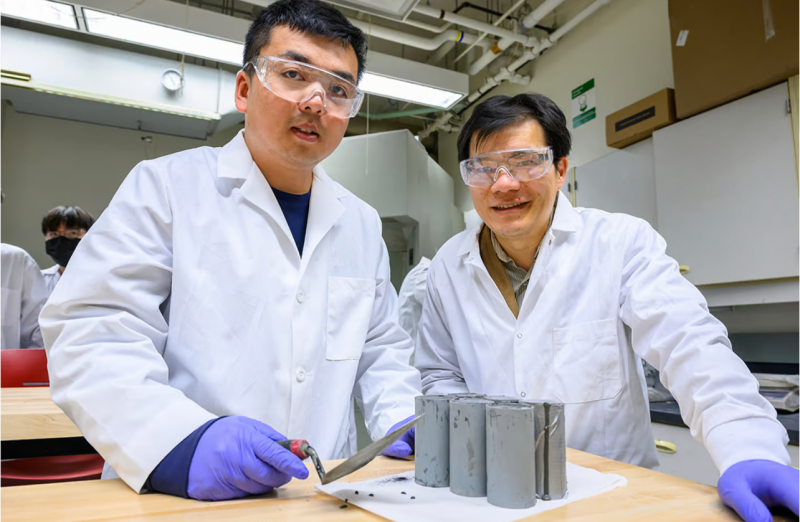New recipe makes concrete that absorbs more CO2 than it emits
Category: News & Politics
Via: hal-a-lujah • 2 years ago • 7 commentsBy: Michael Irving (New Atlas)



Concrete is one of the most common materials on Earth, thanks to its high strength and low cost – but it’s also one of the largest single sources of carbon dioxide emissions. Engineers at Washington State University (WSU) have developed a new method for making concrete that absorbs more carbon than it emits .
The process of making cement requires very high temperatures, and that usually requires burning fuels which, of course, emits CO2. That can be partly offset by switching to renewable energy sources, but chemical reactions in the mixture also release huge amounts of CO2, and this is harder to avoid. All up, it’s estimated that cement production accounts for as much as 8% of humanity’s total carbon dioxide emissions.
Scientists have been tweaking the formula to try to reduce concrete’s carbon footprint , by substituting limestone for volcanic rock , or adding ingredients like titanium dioxide , construction waste , baking soda or a clay commonly discarded during mining. Other teams have even tried using microalgae to grow the required limestone.
For the new study, the WSU researchers investigated a new method involving biochar, a charcoal made from organic waste. While biochar has been added to cement before, this time the team treated it first using concrete washout wastewater. This boosted its strength and allowed a higher proportion of the additive to be mixed in. But most importantly, the biochar was able to absorb up to 23% of its own weight in carbon dioxide from the air around it.
In experiments, the team created cement that contained 30% treated biochar, and found that the resulting concrete was carbon-negative – it actually absorbed more carbon dioxide than was emitted during production of the material. By the researchers’ calculations, 1 kg (2.2 lb) of the 30%-biochar concrete removes about 13 g (-0.5 oz) of CO2 more than its production releases. That might not sound like much, but considering regular concrete is usually responsible for releasing about 0.9 kg (2 lb) of CO2 per 1 kg of material, it’s a stark difference.
The total gains could be even better, the team says, if downstream differences were accounted for in their analysis. For example, using biochar for environmentally friendly purposes like this concrete diverts the biomass it’s made of away from other fates that could potentially release more CO2. Plus, the new concrete would be expected to continue absorbing CO2 during its working lifetime of several decades.
Importantly, the biochar-concrete also retains its strength. When measured after 28 days, the compressive strength of the concrete was 27.6 MPa (4,003 psi), which is around that of regular concrete.
The researchers plan to continue optimizing and scaling up the method, and testing how well the resulting concrete resists weathering and other types of damage.







This could have a huge impact on climate change. Imagine if +8% emissions turned negative with one simple adjustment to the recipe for one of the most widely used construction materials on earth.
That is amazing. When our neighborhood complex is finished there will be 3800 homes plus rec centers and streets. The amount of cement used for this is quite a lot but using the new mixture the amount of carbon dioxide removed from the air would be amazing.
All homes here are built with cement block so there is even more carbon dioxide that could be removed
And here I thought cow farts were the main cause of higher CO2 levels.
Just how many cement plants are there on the planet, for this change of recipe to have any impact on emission levels?
And how would a solid like dried and cured concrete emit a gas like CO2?
Waiting for a scientific explanation.
Concrete never stops curing, therefore if the chemical process of curing concrete is changed in a manner that reduces CO2 emissions, then there is a small but residual impact. For a scientific explanation wait no further. It’s called google.
I once read a comment that said that a person who can get a corn plant to provide two ears of corn instead of just one would do more to cure hunger than all the politicians in the world. So a scientist who creates or discovers a way to reduce by even 10% the negative greenhouse gas potency of cow farts would also qualify to do more to reduce climate change than all the politicians in the world.
Or maybe we all should just quit worrying about it, since there is no practical or realistic way to stop it.
there is no practical or realistic way to stop it.
… besides the obvious solution of reducing the demand for beef. I just got back from a vacation and I can attest that the average American is fat as fuck.